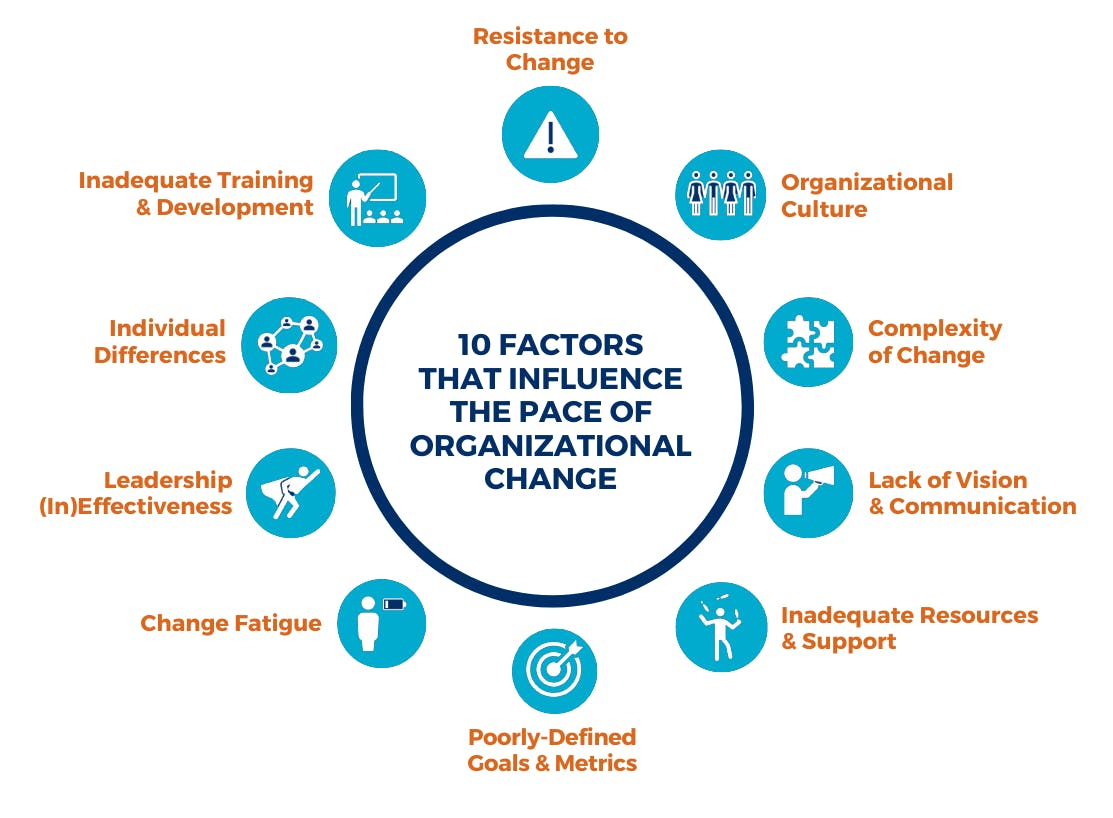10 Factors That Influence the Pace of Organizational Change – and How to Manage Them
For many organizations, change can be a slow and complex process, marked by a series of interconnected challenges that must be overcome to make the transition in a timely manner.
Look inside our playbook to learn 10 factors that often slow the change journey and discover our tips for managing them.

Change in supply chain organizations is rarely simple. It’s a careful balancing act of people, culture, processes, and leadership. Even with strong vision, the journey can be slowed by resistance, complexity, competing priorities, and misaligned resources.
In our Change Management Playbook, we explore 10 critical factors that influence the pace of transformation and share practical strategies to tackle them head‑on. Whether you’re introducing new technology, streamlining operations, or reimagining how teams collaborate, these insights will help you anticipate challenges, avoid costly delays, and secure the buy‑in needed to create lasting, positive change.
❶ Resistance to Change:
We love the familiar and comfortable. Adopting new habits often involves rewiring our brains, and therefore may take some time.
💡 Success Tip:
Did you know that a lot of resistance can actually be predicted? Include steps to anticipate resistance and develop actionable plans to address it in your change preparations. ORTEC provides assistance in identifying and navigating opposition to change.
❷ Organizational Culture:
Does your company’s existing organizational culture unconsciously promote stability over innovation? Some companies aren’t aware of internal mechanisms that inhibit the very change or goals they are trying to achieve. For example: you want to stimulate team effort and encourage people to collaborate, but you maintain bonus structures for individual achievement.
Leaders themselves can be an obstacle to change. They may underestimate the organization’s capacity to evolve. And, they are often given responsibility for driving changes on top of their already busy day-to-day responsibilities, without making space for this new role.
💡 Success Tip:
Ensure all leaders are aligned with critical mission objectives. An unaligned leadership team often leads to failure to reach the goals. It resonates throughout the company, disconnecting employees from a shared sense of purpose. In contrast, when alignment does exist, employees will find value in investing their time, energy, and talents into helping the project succeed.
❸ Complexity of the Change:
The more complex your change, the more detailed planning, coordination, and execution is required. When you just start executing on your change initiative without the proper preparation, you may exert effort but find yourself heading in the wrong direction or encountering unnecessary obstacles along the way.
💡 Success Tip:
Many companies face multiple obstacles due to lack of preparation. These obstacles may negatively impact sentiment and exhaust people to drive change. You need to enlist a partner to see you through this process and ensure you check all the preparation boxes upfront for the best chance to succeed.
❹ Lack of Vision, Engagement & Communication:
A lack of a compelling change vision and inadequate communication will lead to confusion, lack of trust, and slower adoption rates by employees.
💡 Success Tip:
It’s inherently human for team members to want to understand why things need to change in order to adopt new behaviors or processes. Don’t just communicate what you’re doing. Make sure you have a compelling “why” story – including expected outcomes and benefits – to promote employee buy-in.
❺ Inadequate Resources & Support:
In order to succeed, organizational change requires dedicated resources. Many companies find change is necessary, but fail to allocate sufficient resources. Without the right tools to drive and support change, implementation may lag. As the project timeline extends, people may become fatigued over time, which may result in stalled results, or even backward steps.
💡 Success Tip:
To help smooth the journey, clearly define your change implementation team. Make sure you have activated everyone in the right role and help each person involved understand their specific role and objectives. And ensure that you have the budget in place to support the required resources throughout the project lifecycle.
❻ Poorly Defined Goals & Metrics:
How are you going to drive change if you haven’t defined what successful change looks like? How do you assess your effectiveness of change when there is no standard for comparison? Without defining clear goals and metrics to measure progress and hold your team accountable, moving forward will be difficult.
💡 Success Tip:
As noted previously, at this point you should have your team in place and taken steps to ensure that everyone is aligned. Be sure to include experts on the team who can provide insight on the current situation of KPIs and metrics.
Equally important is to remember to assess your Change Management performance itself. You’ll get valuable insights into the overall effectiveness at the time of go live.
If you find an issue, it’s not too late to reassess and change course if needed.
❼ Change Fatigue:
Change Fatigue can be an issue both for employees who need to adopt the change, and for those who are driving that change. The result of multiple changes, or a negative legacy of handling change, without sufficient time for adjustment can lead to lower levels of enthusiasm and slow adoption. This leads to reduced productivity and even turnover of staff.
💡 Success Tip:
Communicate with your team so they understand the reasons for the change, and the expected outcomes it will create. Make sure you have dedicated resources allocated to this critical task. Creating an open culture of communication for everyone to have a voice in the project helps earn buy-in throughout the organization.
❽ Leadership Ineffectiveness:
The change process may face obstacles and delays if leaders lack sustained active and visible project commitment, or don’t provide necessary guidance.
💡 Success Tip:
Are you aware of how people perceive you? Do you know what people expect from you during change? Finding out the answers to these questions and addressing them is fundamental to a successful process. The change starts with YOU. A good change leader acts as a sponsor through the project, not just as the project kickoff. Be the leader, the champion, and the cheerleader for the lifecycle of the project.
❾ Individual Differences & Needs:
Everyone experiences change differently and at their own pace. That means guidance requires individual adjustments for each person involved. Change may take longer for some team members than for others. Taking a 'one-size fits all' approach and failing to acknowledge these differences and address unique needs may derail your change efforts.
💡 Success Tip:
Make sure your people-managers know what their role is in the change project and how they can help guide their direct reports through the transition. Build a timeline that accounts for different ways of working and create checkpoints so that no one person takes on too much responsibility until everyone is comfortable.
❿ Inadequate Training & Development
Most training programs support technical learning. But the bulk of the struggle is seen in translating those training lessons to the reality of daily scenarios and the speed of work.
💡 Success Tip:
Adjust your training beyond the classroom to support “real world” situations and functions specific to your business. If you involve end-users from the beginning, they will help you prepare the right materials to support that part of the phase.
Summary
We’ve explored 10 key factors that can shape — and sometimes slow — your organizational change journey in supply chain logistics. From resistance and cultural barriers to complex processes and leadership alignment, each plays a critical role in determining your speed and success. The path forward demands clear strategy, proactive management, and support that understands the realities of your operation.
As a trusted partner, ORTEC combines deep industry expertise with proven change management practices to help you navigate obstacles, secure buy‑in at every level, and realize measurable transformation. Together, we’ll turn your vision into a streamlined, high‑performing future for your supply chain.
